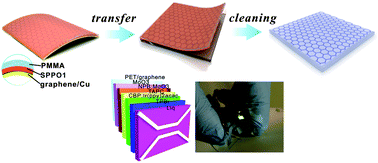Clean surface transfer of graphene films via an effective sandwich method for organic light-emitting diode applications†
Abstract
Graphene shows great promise as a transparent conductive electrode to replace conventional indium tin oxide (ITO) for optoelectronic applications. However, the wide applications of graphene in fields such as organic light emitting diodes (OLEDs) are restricted by the difficulty in obtaining a clean and flat graphene surface, as the large residue generated during graphene transfer can lead to a large short circuit current and consequently degradation of the device performance. Here, we report a novel sandwich method to achieve the efficient transfer of graphene with an ultra-clean and flat surface onto a flexible substrate for OLED applications. Differing from the conventional poly(methyl methacrylate) (PMMA)-supported transfer technique, an organic small molecular buffer layer, e.g., a 2-(diphenylphosphory) spirofluorene (SPPO1) layer, was inserted between PMMA and graphene, forming a PMMA/SPPO1/graphene sandwich structure. The separation of PMMA from graphene, along with the large solubility of SPPO1 in clean solvent, results in a substantial reduction of PMMA residue on the graphene. As expected, flexible OLED devices based on the PMMA/SPPO1 transferred graphene films exhibited a much enhanced performance compared to their counterparts fabricated from PMMA transferred films. Our results demonstrate the great potential of the sandwich transfer technique for the fabrication of high-performance OLED devices, as well as other optoelectronic devices.


 Please wait while we load your content...
Please wait while we load your content...